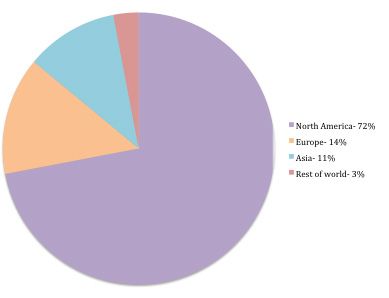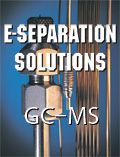Laboratory Automation
The laboratory automation area covers a wide array of technologies, which fall into such categories as liquid handling, robotics, and microplate readers.
The laboratory automation area covers a wide array of technologies, which fall into such categories as liquid handling, robotics, and microplate readers. A liquid handling workstation is typically a robotic device that extracts an exact amount of liquid from one container and transfers it to another container. The major application is to replace manual activities such as pipetting, titrating, diluting, labeling, determining pH, preparing samples, and introducing samples into instruments. The three main types of liquid handling equipment are liquid dispensers, diluters, and XYZ workstations.

Regional distribution of SDi's recent survey of laboratory automation users.
Similar to liquid handlers, lab robotics are a replacement for manual activities, such as moving samples from location to location, stacking and organizing microplates, preparing samples, performing titrations, and introducing samples into instruments. The robotics market is split into two segments: platforms/fully automated workstations and robotic stackers/arms.
A microplate reader quantifies the results of a test or assay performed in the depressions, or wells, of small disposable plastic trays (microplates). The quantification takes place by using several different detection technologies: absorbance, fluorescence, luminescence, and scintillation. Microplate readers have become one of the most basic tools used in biopharmaceutical and life science research for the acquisition and processing of large quantities of biochemical and biological data.
In a recent survey of more than 264 laboratory automation users conducted by Strategic Directions International (SDi), the participants were asked to indicate the best characteristics of their recently purchased laboratory automation system. System reliability, software ease-of-use, and flexibility were among the most frequently mentioned characteristics.
The accompanying graph shows the regional distribution of respondents to the survey. North America (Canada, United States, Mexico) represented the largest segment of respondents, followed by Europe, and Asia (Japan, China, Pacific Rim).
The foregoing data was extracted SDi’s Tactical Sales and Marketing (TSM) report entitled: Laboratory Automation: Understanding Market Trends and End-User Attitudes.> For more information, contact Glenn Cudiamat, VP of Research Services, Strategic Directions International, Inc., 6242 Westchester Parkway, Suite 100, Los Angeles, CA 90045, tel. (310) 641-4982, fax (310) 641-8851, e-mail:cudiamat@strategic-directions.com
Regulatory Deadlines and Supply Chain Challenges Take Center Stage in Nitrosamine Discussion
April 10th 2025During an LCGC International peer exchange, Aloka Srinivasan, Mayank Bhanti, and Amber Burch discussed the regulatory deadlines and supply chain challenges that come with nitrosamine analysis.
Top Execs from Agilent, Waters, and Bruker Take the Stage at J.P. Morgan Healthcare Conference
January 16th 2025The 43rd Annual Healthcare J.P. Morgan Healthcare Conference kicked off in San Francisco earlier this week. Here’s what top executives from Agilent, Bruker, and Waters, discussed during the event.




